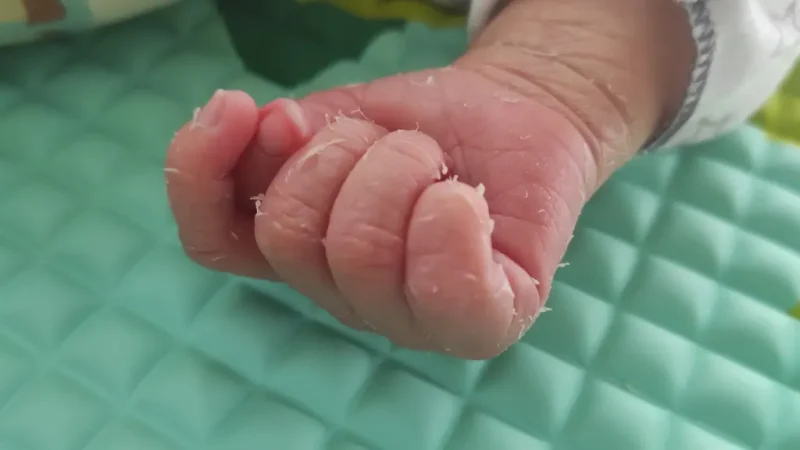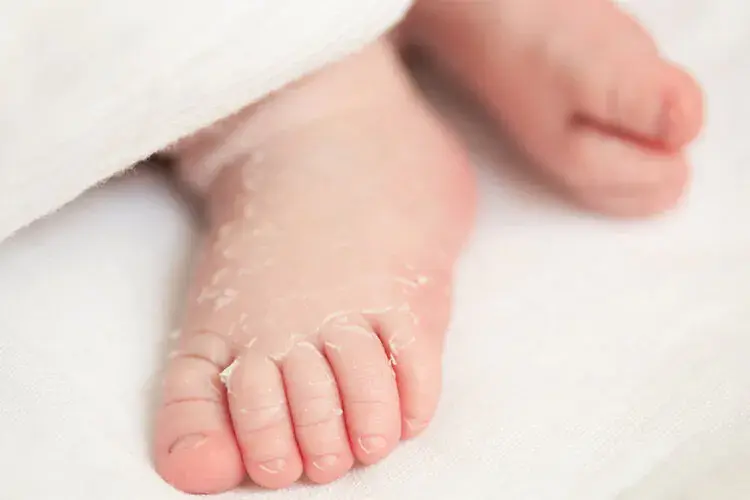Is it normal for a newborn skin to peel? Many new parents are concerned about this as they witness their little one’s delicate skin shedding its outer layer.
The answer is a resounding yes – peeling skin in newborns is not only normal but also expected and part of a healthy developmental process.
Flaky or peeling skin is expected at this stage as the baby’s skin adapts to the outside world after spending months in the womb’s protective environment.
In this article, we’ll dive deep into the reasons behind newborn skin peeling, when it typically occurs, how to care for your baby’s skin during this transition, and when to seek medical attention if necessary.

We’ll also provide helpful tips for parents navigating this phase, ensuring you feel prepared and confident in nurturing your little one’s delicate skin.
Is it normal for a newborn skin to peel?
Flaky or peeling skin is expected at this stage. It’s a natural and expected part of a newborn’s development as their delicate skin adjusts to the world outside the womb.
The peeling allows the outer protective layer to shed, revealing the fresh, new skin underneath. This shedding process is harmless and temporary. Last, go to more details…
Why Newborn Skin Peels
Picture this: your little one spent nine cozy months in your womb, surrounded by a protective layer called the vernix caseosa.
This creamy substance acts as a barrier, shielding your baby’s skin from the amniotic fluid. However, once your newborn emerges into the world, this coating starts to shed, revealing the fresh, new skin underneath.
But that’s not the only reason for the peeling. Your baby’s skin also needs to adapt to the dry environment outside the womb.
Throughout the pregnancy, your little one was surrounded by a constant supply of moisture, but now they must adjust to the drier air.
This transition can cause the outermost layer of skin to flake off, allowing the new, more mature skin to take its place.
It’s like a butterfly emerging from its cocoon – a beautiful transformation that’s all part of nature’s plan.
When Peeling Typically Occurs
Now, let’s talk about timing. When can you expect to witness this natural shedding process? Well, it typically begins within the first few weeks after birth.
However, the timing can vary slightly from baby to baby, as each little one is unique and special in their way.
Here’s a handy timetable to give you an idea of what to expect:
| Age of the Baby | Peeling Occurrence |
|---|---|
| 1-2 weeks | Peeling may start, particularly on the hands, feet, and ankles |
| 2-4 weeks | Peeling is likely to be more noticeable |
| 4-6 weeks | Peeling should subside as the skin matures |
Remember, this is just a general guideline, and your baby’s skin may follow a slightly different timeline. The key is to embrace this natural process and trust that your little one’s body knows exactly what it’s doing.
Is Peeling Normal?

Absolutely! Peeling skin in newborns is not only normal but also expected and completely harmless. It’s simply your baby’s way of shedding the protective layers they no longer need and revealing their brand-new, beautiful skin.
Think of it as a fresh start, a clean slate for your little one’s journey in the world. Just like a snake sheds its old skin to make way for new growth, your baby’s peeling is a sign of healthy development and maturation.
So, breathe easy, dear parents, and embrace this natural process with open arms. It’s a testament to the incredible ways in which your baby is adapting and thriving in their new environment.
How to Care for Peeling Newborn Skin
While peeling skin is perfectly normal, it’s essential to take good care of your baby’s delicate skin during this time. Here are some gentle tips to keep in mind:
- Bathing: Stick to gentle, fragrance-free cleansers and avoid harsh soaps that can strip away natural oils. Keep bath times short and use lukewarm water to prevent further drying.
- Moisturizing: After bath time, pat your baby’s skin dry (don’t rub!) and apply a mild, fragrance-free moisturizer to help lock in hydration. Look for products specifically formulated for newborns or those with minimal ingredients.
- Gentle Handling: Resist the temptation to pick or peel off the flaking skin yourself. Let it shed naturally, as forceful removal can cause discomfort or irritation.
- Soft Fabrics: Dress your baby in soft, breathable fabrics like cotton to prevent further irritation or friction against their delicate skin.
- Nail Care: Trim your child’s nails to prevent accidental scratching, which could lead to infection or scarring.
Remember, a little extra TLC goes a long way when it comes to nurturing your newborn’s sensitive skin during this transitional phase.
When to Seek Medical Attention
While peeling skin is typically harmless, there are a few instances when you should seek medical advice from your pediatrician:
- Severe or Widespread Peeling: If the peeling seems excessive or covers large areas of your baby’s body, it’s best to have it checked out.
- Peeling Accompanied by Other Symptoms: If the peeling is accompanied by redness, swelling, oozing, or other concerning symptoms, it could be a sign of an underlying condition that requires medical attention.
- Peeling Doesn’t Subside: If the peeling persists beyond the first few weeks or seems to worsen, consult your pediatrician for guidance.
Remember, it’s always better to err on the side of caution when it comes to your little one’s health and well-being.
Tips for Parents
As you navigate this new phase with your newborn, here are some additional tips to keep in mind:
- Be Patient: Peeling is a gradual process, and it may take a few weeks for your baby’s skin to shed and fully reveal its new, fresh layer. Embrace the journey and enjoy every moment with your little one.
- Dress for Comfort: Opt for loose, breathable clothing that won’t irritate or rub against your baby’s peeling skin. Cotton onesies and soft fabrics are perfect choices.
- Keep Nails Trimmed: As mentioned earlier, regularly trimming your baby’s nails can prevent accidental scratching and allow the peeling process to occur naturally.
- Capture the Memories: Don’t forget to take plenty of pictures! Your baby’s peeling skin is a unique and fleeting stage that you’ll cherish forever.
- Trust Your Instincts: If something doesn’t feel quite right or you have any concerns, don’t hesitate to contact your pediatrician. They’re there to support you and provide guidance throughout this incredible journey of parenthood.
Why Is My Newborn’s Skin Peeling?
Read this article ( Why Is My Newborn’s Skin Peeling? A Friendly Guide For New Parents )
If 3 months of baby skin peeling?
You can read it here. Everything is very nicely said. ( 3 Month Old Baby Skin Peeling: A Completely Normal (And Common) Occurrence )
Conclusion
As you’ve learned, peeling skin in newborns is natural and expected. It’s your baby’s way of shedding protective layers and revealing brand-new, beautiful skin.
While it may seem a bit daunting at first, embracing this process with patience, gentle care, and a positive mindset will make all the difference.
Remember, every baby is unique, and their skin may follow a slightly different timeline. As long as you provide a nurturing environment, moisturize regularly, and seek medical advice if you have any concerns, your little one’s skin will blossom into its full radiant glory.
So, take a deep breath, cherish these fleeting moments, and revel in the wonder of your newborn’s growth and development.
After all, peeling skin is just one small part of the incredible journey ahead, filled with countless milestones, laughter, and love.

